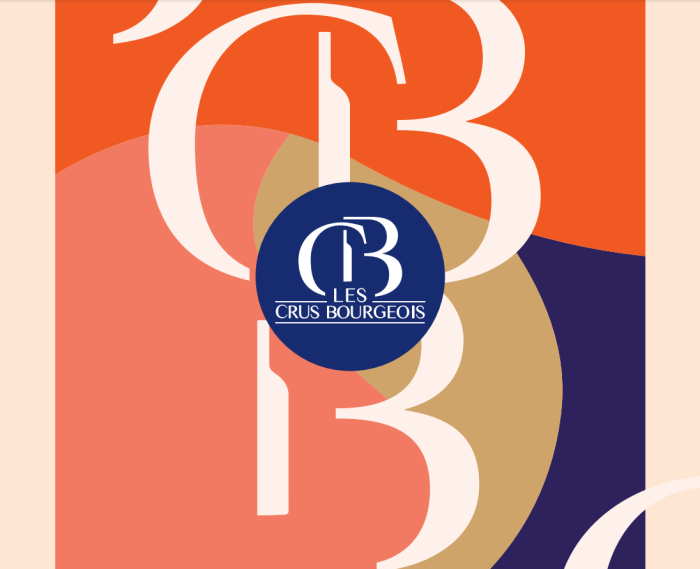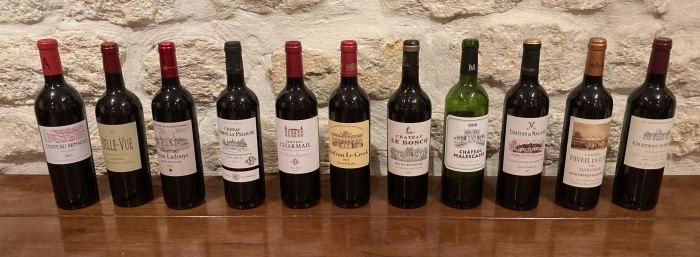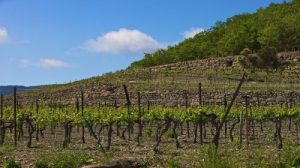
Bordeaux is particularly well-known for its 1855 grand crus classé . Over last few decades, most of these magnificent wines have become out of reach for some wine lovers. But we have some good news for you, as in the Médoc, you’ll find many Crus Bourgeois wines which come from a classification started in 1932 and is regularly revisited.
A classification in perpetual motion
While there are some Bordeaux classifications that have remained near enough the same over the last 150 years, the Cru Bourgeois list is revisited every five years, a decision that was made in 2018. To claim a spot, the châteaux have to be located in one of the prestigious Médoc AOCs (Médoc, Haut-Médoc, Listrac-Médoc, Moulis-en-Médoc, Margaux, Saint-Julien, Pauillac et Saint-Estèphe) and meet other, precise criteria including environment requirements,
The 2025 Classification – 14 Crus Bourgeois Exceptionnels
A tasting committee evaluates the wine, tasting them blind to remove any possibilities of bias. Following the 2003 classification being later annulled, some top Bordeaux châteaux turned their backs on the Cru Bourgeois classification due to a lack of consistency. The new system has been designed to address this problem and provide greater clarity. Since 2020, the classification has been organised into a three-level pyramid with the top level reserved for the properties that meet particularly stringent requirements. In 2025, estates classified as Cru Bourgeois Exceptionnels had to hold a level 2 or 3 environmental certificate and to have been awarded the best average ratings for their five most recent vintages, with the estate’s folder on subjects like respect for the environment, traceability, authenticity, and commercial aspects (reputation, presence at high-end restaurants, etc.) being studied.
170 properties make up the classification; 120 are classed as Cru Bourgeois, 36 are Cru Bourgeois Supérieur and only 14 as Cru Bourgeois Exceptionnel.
Here is the list of the 14 Cru Bourgeois Exceptionnel from 2025:
- Château la Cardonne (Médoc AOC)
- Château Castera (Médoc AOC)
- Château Laujac (Médoc AOC)
- Château Malescasse (Haut-Médoc AOC)
- Château de Malleret (Haut-Médoc AOC)
- Château Paloumey (Haut-Médoc AOC)
- Château Reysson (Haut-Médoc AOC)
- Château du Taillan (Haut-Médoc AOC)
- Château Reverdi (Listrac-Médoc AOC)
- Château d’Arsac (Margaux AOC)
- Château Mongravey (Margaux AOC)
- Château Paveil de Luze (Margaux AOC)
- Château le Crock (Saint-Estèphe AOC)
- Château Laffitte Carcasset (Saint-Estèphe AOC)
The bottles of wine from these estates will be able to have ‘’ written on their label from the 2023 vintage and the next time the classification is revisited will be in 2030. Incidentally, two mixed cases from the old classification drawn up in 2020 can be found on iDealwine – one with bottles from the 2019 vintage and the other from 2020.
Tasting the 14 Cru Bourgeois Exceptionnel
In 2023, we had the opportunity to taste the 14 Cru Bourgeois Exceptionnel from the 2018 vintage which were named as Cru Bourgeois Exceptionnel in the 2020 rankings. Tasting them revealed the impressive regularity produced by the châteaux in the Médoc. Forming a family, these wines are the driving force behind the appellation and the Crus Bourgeois classification…
Château du Taillan: A Cru Bourgeois since 1932, it was classified as a Cru Bourgeois Supérieur in 2003 and a Cru Bourgeois Exceptionnel in 2020. The château is run by five women who are the fourth generation of the family to make wine here and it stretches over 105 hectares, 26 of which are located in the Haut-Médoc appellation. The site has been classified as an historic monument with a wonderful 18th century château and underground cellars dating back to the 16th century. The wine’s fine tannins bring black fruits flavours, a beautiful balance, and a pleasant, slight minty aroma along with them. The 12 months spent ageing differs from many other wines which mature for around 18 months.
Château Le Crock: This 32-hectare château crafts wines from its vines that are on average 50 years old (for reference, most other vines in the classification are about 30 years old). A classic wine with black fruit aromas and a touch of vanilla, it’s well-balanced and a little discrete (a wine to leave in the cellar for a bit).
Château Malescasse: Built at the start of the 19th century, the château sits on a gravelly knoll with 40 hectares of vines. Holding a HVE3 (Level 3 Higher Environmental Value, an environmental certificate awarded in France), its vineyards have witnessed a restructuring in recent years. Tasting it reveals spices, liquorice, cedar and tannic aromas.
Château de Malleret: It has been in the hands of the same family since 1850 and has 60 hectares of wines to its name. Here, vines and horses mix; one of the family’s horses has just won a horse competition in Austria (over the weekend of 7-8 October 2023). On the palate, the wine is very fine, with a great freshness and a cutting initial drop.
Château Paveil de Luze: A family-owned property since 1862, it covers 70 hectares, 32 of which are full of vines, in Margaux. The estate has never been divided up and it’s for that reason that the vines are tended to by only one person. Stéphane Derenoncourt advises the family from time to time. Tasting it reveals tannins and a freshness, and classic red and black fruit flavours. Juicy with a melting finish.
Château d’Arsac: AOC Margaux. In 1706, this property stretched over 543 hectares, 260 of which were covered with vines. By 1986, it only had 5 hectares to its name having been completely abandoned when Philippe Raoux purchased it. Today, it has 106 hectares in production, 54 in Margaux and 48 in Haut Médoc (Château le Monteil d’Arsac). Two varieties are at the heart of all it does: Cabernet Sauvignon and Merlot. This classic wine contains spiced and toasted coffee aromas, power tannins and a long finish.
The following chateau have been downgraded or are no longer a part of the Cru Bourgeois classification: Château d’Agassac, Château Arnauld, Château Belle-Vue, Château Cambon La Pelouse, Château Charmail, Château Lestage, Château Le Boscq and Château Lilian Ladouys.

Wines added to the Cru Bourgeois Exceptionnel list are:
Château la Cardonne: Located in the Médoc AOC. The property consist of 55 hectares of vignes. The Charloux family has owned the estates since 1990 after having been under the aegis of Château Lafite-Rothschild. The vines are 54% Cabernet Sauvignon, 41% Merlot and 5% Petit Verdot.
Château Castera: Owned by Thomas C.Press, it is located in the Médoc AOC. The vineyards are 63 hectares in size and are dominated by Merlot followed by Cabernet Sauvignon, Cabernet Franc and Petit Verdot. Since the creation of the Crus Bourgeois rankings in 1932, Château Castera has feature in them.
Château Laujac: This is a winemaking estate which also tends cows and horses in a well-created ecosystem. OUt of the property’s 450 hectares, 75 are planted with vines (mainly Cabernet Sauvignon as well as Merlot and Petit Verdot). Vanessa Cruse Duboscq is the owner and CEO, representing the 6th generation of the family.
Château Paloumey: Pierre Cazeneuve manages this estate employing organic methods. The vineyards are composed of 50% Cabernet Sauvignon, 44% Merlot supported by Cabernet Franc and Petit Verdot. To adapt to climate change, research has been carried out to improve how work is conducted in the vineyard.
Château Reysson: Maison Dourthe has owned this property since 2014. The soils are very similar to those you find in Saint-Emilion, based on a mixture of limestone and clay, meaning Merlot is perfectly adapted to this unique Médoc terroir.
Château Reverdi: This estate has been owned by the same family since 1953 and covers 32 hectares. The château has a well-thought through wine tourism offering and received an award from Best of Wine Tourism in 2011.
Château Mongravey: This property created in 198 is composed of 12 hectares of vines located in Margaux. Two generation run the operations there: Régis, Jérôme and Karin Bernaleau.
Château Laffitte Carcasset: This is a historic property in the Saint-Estèphe appellation and its vineyards were first plated way back in 1759. It has been managed by Pierre Rousseau since 2016. THe soils are made up of gravel and clay and the vines are a classic mix of Cabernet Sauvignon, Merlot and Cabernet Franc.
The Top 5 Best Crus Bourgeois Exceptionnels according to iDealwine:
- Château Malleret
- Château du Taillan
- Château Paveil de Luze
- Château Le Crock
- Château Paloumey
New gems to discover:
- Château Laffitte Carcasset
- Château Mongravey



